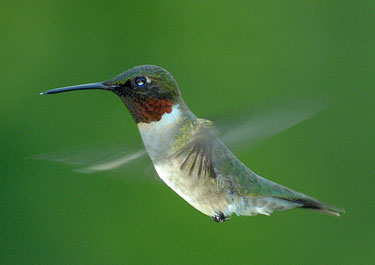Ruby-throated hummingbird
The ruby-throated hummingbird (Archilochus colubris) is the most common species of hummingbird found in Alabama, seen mostly during the summer.
Physical characteristics
Ruby-throated hummingbirds display a prominent sexual dimorphism in that the males have a deep red "gorget" or throat, with a black chin above, while the female has a white throat and white-tipped tail feathers. Both sexes have iridescent green feathers along the back. The average weight of one of these hummingbirds ranges from .07-.21 oz, and from beak to tail their size ranges from 2-4".
Natural history
Ruby-throated hummingbirds typically live at the edges of forests or clearings, and range throughout the entire eastern United States, including up into Canada. Their diet consists of nectar from tubular red and orange flowers, occasional tree sap, and small insects. Due to their shortened legs, hummingbirds have trouble walking, but can shuffle along perches. Male courtship displays consists of large u-shape dives and swift side-to-side movements. Females will lay between 1-3 very small eggs per clutch. The eggs will take about 20 days to hatch. The oldest known ruby-throated hummingbird was one month over 9 years old.
Migration
During the winter, ruby-throated hummingbirds migrate to Mexico and Central America using the Mississippi Flyway, which is a migration path that follows the Mississippi River. The birds leave the United States from the Gulf of Mexico and fly non-stop to their destination. In order to survive the journey, the hummingbirds double their body weight before they migrate over the gulf.
Conservation status
Ruby-throated hummingbirds are listed as "least-concern" by the International Union for Conservation of Nature, meaning that populations are stable and are not currently threatened.
References
- Wilson, Jim and Anselm Atkins (2002) Common Birds of Birmingham 2nd edition. Decatur, Georgia: Hexagon Publishers ISBN 096672402X
- "Ruby-throated hummingbird." All About Birds, Cornell Lab of Ornithology.
